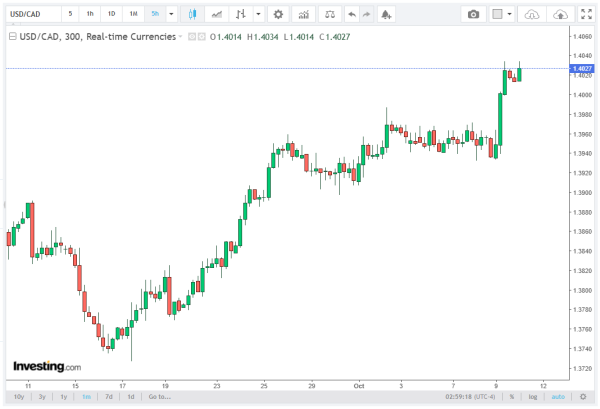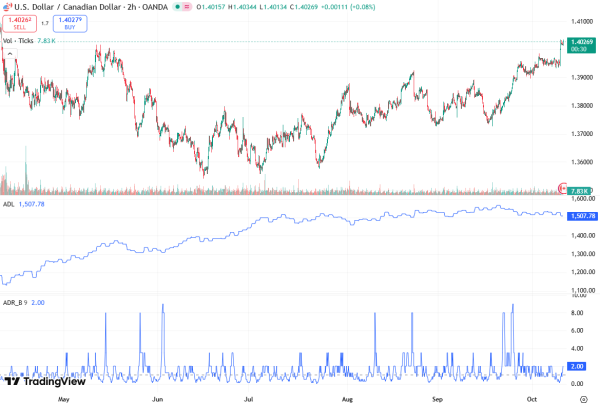The USD/CAD currency pair remains steady above the 1.4000 level, holding near six-month highs as Oil prices retreat. After gaining around 0.5% in the previous session, the pair traded around 1.4020 during Asian trading hours, reflecting the ongoing influence of commodity-linked movements and US economic data.
The Solancie team offers a structured and informative breakdown of this matter.
USD/CAD Gains on Lower Oil Prices
The Canadian Dollar (CAD) is facing pressure amid declining crude Oil prices, leading to a steady USD/CAD. The pair touched a six-month high of 1.4033 on Thursday before slightly retreating. The US Dollar (USD) remains broadly supported, bolstered by risk-off sentiment and geopolitical developments.
As Canada is one of the largest Oil exporters to the United States (US), the CAD is sensitive to fluctuations in Oil markets. On Friday, West Texas Intermediate (WTI) crude traded around $61.20 per barrel, reflecting a dip after the easing of geopolitical risk premiums.
The recent agreement between Israel and Hamas on a first-phase ceasefire plan alleviated tensions in the region, reducing the immediate risk-driven demand for Oil.
Geopolitical Developments Impact Oil and CAD
WTI prices came under pressure as the geopolitical risk premium, which had previously supported Oil, declined following the announcement of the Israel-Hamas agreement. Lower Oil prices naturally weigh on the CAD, a currency closely linked to commodity exports, particularly crude Oil.
The weakening CAD contributed to the USD/CAD rally, as investors favored the Greenback in the wake of Oil-related volatility. The USD continues to benefit from ongoing risk aversion, including concerns over the US government shutdown.
As of Friday, the US Senate remained deadlocked on legislation to end the shutdown, providing additional support to the USD.
US Dollar Holds Ground Despite Short-Term Pullback
Although USD/CAD is inching lower after a brief pullback, the US Dollar remains resilient. The pair’s retreat from the six-month high is minor, as USD strength persists amid market uncertainty and risk-off positioning.
Factors supporting the USD include macroeconomic stability and cautious monetary policy signals. Market participants are weighing the impacts of fiscal challenges, such as the ongoing government shutdown, alongside the Federal Reserve’s policy stance.

Fed Officials Signal Dovish Bias
Dovish sentiment surrounding the US Federal Reserve (Fed) has introduced some headwinds for the Greenback, but the USD/CAD remains elevated due to external pressures. On Friday, San Francisco Fed President Mary Daly highlighted that inflation has eased more than anticipated. Daly stated that the Fed expects further risk management cuts, signaling a potentially slower pace of monetary tightening.
Similarly, Fed Governor Michael Barr emphasized the difficulty in judging the appropriate monetary policy stance amid current economic conditions. He noted that the September rate cut was appropriate and that the current policy rate remains modestly restrictive. Barr also indicated that the US government shutdown could have uncertain implications for the overall economy, complicating forecasts for the USD.
USD/CAD Outlook Amid Economic and Commodity Drivers
The near-term outlook for USD/CAD is influenced by a combination of commodity dynamics, US fiscal developments, and Fed policy signals. While the pair’s recent gains reflect CAD weakness due to falling Oil prices, the USD could face challenges if Fed guidance remains dovish and risk sentiment improves.

Technical traders are watching the 1.4000 support level closely, as a breach could signal further USD/CAD retracement, whereas sustained trading above 1.4030 may point to continued Greenback strength.
Meanwhile, Oil market developments remain a critical driver. Any resurgence in WTI prices or renewed geopolitical tensions could bolster the CAD, exerting downward pressure on USD/CAD. Conversely, easing tensions and weaker Oil demand would likely support further USD appreciation against the commodity-linked CAD.
Key Takeaways
USD/CAD remains above 1.4000, hovering near six-month highs, supported by a weaker Canadian dollar amid declining oil prices. WTI crude trades around $61.20 per barrel, pressured as geopolitical risk premiums ease following the Israel-Hamas agreement.
The US dollar’s strength is also partially driven by ongoing risk aversion linked to concerns over a potential US government shutdown. Fed officials, including Mary Daly and Michael Barr, have signaled a dovish outlook, highlighting the possibility of additional risk-management cuts and noting prevailing economic uncertainties.
Key technical levels to watch include 1.4000 as support and 1.4030 as resistance, with the USD/CAD trend remaining highly sensitive to oil price movements as well as US fiscal and monetary developments.
The interplay between commodity markets, US fiscal uncertainty, and Fed policy continues to shape USD/CAD movements. Traders are advised to monitor Oil prices, Fed commentary, and the government shutdown progress, as these factors are likely to dictate short-term volatility and medium-term trends in the USD/CAD currency pair.









